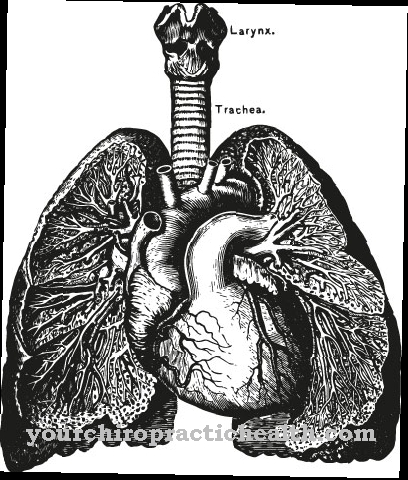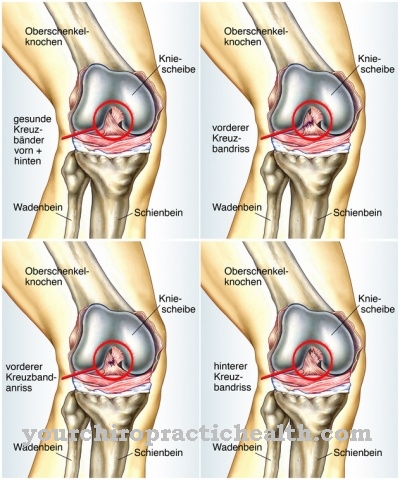At the Hyperabduction syndrome A vascular nerve cord of the arm jams under the bony process of the shoulder blade and thus causes disturbances in sensitivity and blood flow. Most patients with the syndrome only complain of symptoms when they bring the arms headward to maximum abduction. Therapy is usually not required.
What is hyperabduction syndrome?

© lesterman - stock.adobe.com
In anatomy, abduction means extending the arm or leg away from the center of the body. The Hyperabduction syndrome is a rare occurrence that occurs with abduction of the arm and simultaneous dorsal movement of the extremity. The syndrome is characterized by a compression of the vascular nerve cord on the arm and is characterized by symptoms such as sensitivity disorders.
In hyperabduction syndrome, the compression of the vascular nerve cord corresponds to an obstruction under the Coracoid process. It is a bony extension of the shoulder blade. The syndrome is therefore also called neurovascular abduction syndrome designated. Many neurovascular syndromes are grouped under the term thoracic outlet syndrome.
In addition to hyperabduction syndrome, this group of diseases includes, for example, pectoralis minor syndrome, Paget von Schroetter syndrome and costoclavicular syndrome. The clinical picture of a neurovascular syndrome can in individual cases be very similar to other syndromes from this group.
causes
The cause of hyperabduction syndrome is movement of the arm. The causal movement is an extraordinarily strong abduction with simultaneous dorsal movement of the upper extremity, which pushes the nerve-vascular cord in the shoulder area under the bony extension of the shoulder.
Since veins are blocked, the arm is no longer adequately supplied with blood after the vascular nerve cord is compressed and can become cold or fall asleep, for example. Because nerves are also jammed when the vascular nerve cord is compressed, the syndrome can also cause neurological symptoms. Common symptoms of neurology in this context are abnormal sensations in the fingers or hands.
A feeling of numbness or heaviness in the arm as a result of the compression can just as easily set in as any coordination disorders in the affected extremity. Disturbances in deep sensitivity can also be traced back to the jamming of the vascular nerve cord. Often the syndrome is associated with a pre-existing tightness under the coracoid process.
Symptoms, ailments & signs
Hyperabduction syndrome patients suffer from a complex of symptoms of circulatory and nerve disorders. After the maximum feeding movement or a maximum lifting movement of the arm, a reduced blood supply to the extremity occurs, which is primarily expressed in coldness or in the arm falling asleep.
The nerve disorders manifest themselves as sensitivity disorders of the fingers, for example in the form of numbness or at least reduced sensitivity. In some cases, the patients describe the symptoms they experience similar to Raynaud's syndrome. In this context, they speak, for example, of radiating pain or sudden paleness of the affected arm.
Knocking or tingling sensations can also be symptomatic. The skin may turn red. Radiated pain occurs mainly in those who suffer from an existing tightness below the shoulder blade process. Typically, the symptoms mostly appear during sleep and wake the patient up.
Diagnosis & course of disease
The doctor usually makes the diagnosis of hyperabduction syndrome based on the medical history and further confirms it with a physical examination. Usually he will do a provocation test or Adson test. He can, for example, ask the patient to spread their arms as far as possible or to raise them as much as possible.
If there is hyperabduction syndrome, the nerve-vascular cord will then become jammed under the bony extension of the shoulder blade. After about two minutes, the radial pulse should actually still be palpable. However, if there is a narrowing under the shoulder process or under the pectoralis minor muscle, radiating pain occurs after two minutes and the doctor can hardly feel the radial pulse.
Complications
The hyperabduction syndrome mainly leads to disturbances of the sensitivity and the blood circulation in the arm of the patient. In most cases, however, only one side of the body is affected. The arm feels asleep and may tingle or hurt slightly. Typically, hyperabduction syndrome is not a dangerous syndrome that must be treated. The symptoms usually go away on their own.
Numbness can develop, which can suddenly lead to severe pain. This may result in restrictions in everyday life and movement for the patient. It is not uncommon for the arm to be reddened or itchy. There are no complications. In most cases, the symptoms arise during sleep, which can lead to sleep disorders in the patient.
Life expectancy is not restricted by hyperabduction syndrome. In most cases, hyperabduction syndrome is not treated. Surgical treatment can only be carried out by the doctor when the symptoms restrict everyday life too much. However, the life expectancy of the patient is not restricted by the syndrome.
When should you go to the doctor?
In the case of hyperabduction syndrome, treatment by a doctor is always necessary. This disease does not heal itself and in many cases the symptoms worsen. A doctor should be consulted if the person concerned suffers from sensory disturbances or from circulatory disorders frequently and for no particular reason. Limbs can fall asleep or tingle. Likewise, constant numbness in the extremities can indicate hyperabduction syndrome and should be evaluated by a doctor.
The affected areas of the body may also be painful or swollen. Reddened skin also indicates the disease. Most complaints occur during sleep and can have a negative impact on the quality of sleep or even wake the person affected. Usually, hyperabduction syndrome can be diagnosed by a general practitioner. During the treatment, however, interventions by various specialists are necessary in order to permanently resolve the symptoms. The life expectancy of the person affected is usually not reduced by the disease.
Doctors & therapists in your area
Therapy & Treatment
The hyperabduction syndrome only requires further therapy in the rarest of cases. The disturbances that occur are unpleasant, but not dangerous. Apart from that, they usually dissolve into thin air as soon as the person repositions the arm. If the patient suffers from the syndrome, the doctor may recommend a more conservative therapy method that involves attaching his arm to the leg on either side before going to bed.
In the position fixed in this way, there are no more complaints because the arm can no longer be brought to maximum abduction towards the head. A conventional sling can be used for fixation. If there is a severe tightness under the pectoralis minor muscle and the shoulder blade, an invasive procedure can be used to causally resolve the tightness. Such an intervention is only indicated if the blockage persists and the vessels and nerves are in danger of permanent damage.
In patients whose profession regularly requires maximum head abduction of the arms, the surgical resolution of the existing tightness can make sense, for example. The operation takes the form of a deinsertion of the pectoralis minor muscle. As a rule, the hyperabduction syndrome never occurs again in patients treated in this way.
You can find your medication here
➔ Medicines for paresthesia and circulatory disordersOutlook & forecast
The prognosis for hyperabduction syndrome is very favorable. Normally there is no need for action, as spontaneous healing occurs. The complaints recede completely on their own within a short time. Long-term consequential damage or impairment is not to be expected. The inconvenience that occurs is of a temporary nature and does not cause permanent damage. Adequate rest and rest should be provided for freedom from symptoms. This will shorten the healing time. In addition, the self-healing powers are better activated.
Hyperabduction syndrome can recur in the course of life. In these cases the prognosis is also favorable. The recurrence of the symptoms does not lead to any changes in the healing process. If the person concerned continues to stress his body in spite of the symptoms, a delay in the healing process can be expected. This interrupts the time required for regeneration and triggers the delays. So that there is no consequential damage or inflammation in the organism, the person affected should adhere to the guidelines for rest or immobilization of the arm. Otherwise, complications are to be expected.
If medication is taken because of the pain present, there may be risks and side effects. The herbs have a negative influence on certain organs and lead to addiction in many people.
prevention
The hyperabduction syndrome can be avoided by not bringing the arms towards the head to maximum abduction, especially when sleeping. This can be done, for example, with a sling that connects the arms with the legs and thus prevents the abduction movement over the head.
Aftercare
In the case of hyperabduction syndrome, there are no special measures or options for follow-up care available to those affected. The patient is primarily dependent on a quick and early diagnosis so that there is no further worsening of the symptoms or further complications. There can be no independent healing, so the early detection and treatment of this disease is in the foreground.
In most cases of hyperabduction syndrome, restraint can be done to relieve the discomfort. This should be maintained until the symptoms have completely disappeared. However, treatment is not always necessary for hyperabduction syndrome. However, surgery may be needed to relieve symptoms.
After such an operation, the person concerned should definitely rest and take care of his body. Avoid stressful or physical activity to speed healing. The help and support of your own family and friends can also be useful.It is also often worth making contact with other sufferers of this disease, as this leads to an exchange of information.
You can do that yourself
In many cases, hyperabduction syndrome can be prevented directly by not positioning the arms above their head while sleeping. In severe cases, a sling can be used to connect the legs to the arms to prevent movement.
In many cases, however, treatment for the syndrome is not necessary. This also applies if the patient suffers from restrictions in his everyday life. Although these can be uncomfortable, they do not always require treatment. If the person concerned is dependent on the abduction movement in their everyday life or because of their job, a surgical intervention may be necessary. There are no possibilities for self-help for the patient. As a general rule, you should refrain from any activity or movement that leads to symptoms of hyperabduction syndrome. If the patient suffers from reduced sensitivity due to the syndrome, this can possibly be alleviated by massages or the application of heat.
In many cases, the symptoms go away on their own as soon as the arms are brought into a normal position. If the symptoms occur regularly, it is highly advisable to see a doctor.



.jpg)


.jpg)

















.jpg)



